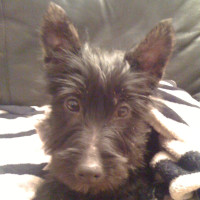Appearance of the Scorkie
|
| The Scorkie is a cross between the wire-haired Scottish Terrier and the silky-haired Yorkshire Terrier, both breeds from Scotland. The resulting hybrid may resemble either parent, and is sure to be compact and low to the ground. The Scorkie's coat is generally long, and can range in color from solid black to gray and tan, depending on which of its parents is most represented in the breed. The Scorkie's head is square-shaped, with a long muzzle and long, beard-like hair. The eyes are large, round and brown, and the Scorkie's ears are triangular and erect. The Scorkie has short legs, and its body is low to the ground. The Scorkie's tail is carried high and is often docked. |
Temperament of the Scorkie
|
| The Scorkie is a loyal, affectionate dog that can become a one-man companion. They can be independent-minded, and require firm, gentle training from an early age to rid them of their stubbornness. The Scorkie is well suited to bachelors and the elderly, but can also be affectionate with older, calm children. They are alarm barkers and will alert their master to the approach of strangers, but otherwise the Scorkie is curious and friendly towards new people once the threat has been assessed. The Scorkie's energy level is low, but it needs daily exercise to maintain a healthy body and mind. |
Needs and activities of the Scorkie
|
| The Scorkie is a low-energy dog, but still needs daily exercise. The intensity of exercise doesn't need to be very high, and the Scorkie won't be a good jogging partner given its short legs. He is able to do most of his daily activities indoors, walking around the house or apartment or on his daily potty breaks. The Scorkie, although native to a cold climate in Scotland, does not tolerate extreme temperatures and prefers a controlled indoor climate. Their small size and need for activity mean they adapt well to apartment and city living, but they also need mental stimulation to prevent the onset of negative behaviors, such as digging and chewing. |
Maintenance of the Scorkie
|
| The Scorkie is a hypoallergenic dog with a low tendency to shed or drool. Weekly or twice-weekly brushing helps prevent tangles from forming in the coat, and removes dead or loose hairs that get stuck in the double coat. Scorkies have sensitive skin and can develop allergic dermatitis if their natural oils are removed during bathing. Owners should avoid bathing if possible, and use a pimpled or bristle brush to help distribute the natural oils on the skin. Weekly brushing will also help remove any dirt or debris that may get caught in the bristles during travel. |









 English (United Kingdom)
English (United Kingdom)